
Macanese patois is a Portuguese-based creole language with a substrate from Cantonese, Malay and Sinhala, which was originally spoken by the Macanese community of the Portuguese colony of Macau. It is now spoken by a few families in Macau and in the Macanese diaspora.

The Manueline, occasionally known as Portuguese late Gothic, is the sumptuous, composite Portuguese architectural style originating in the 16th century, during the Portuguese Renaissance and Age of Discoveries. Manueline architecture incorporates maritime elements and representations of the discoveries brought from the voyages of Vasco da Gama and Pedro Álvares Cabral. This innovative style synthesizes aspects of Late Gothic Flamboyant architecture with original motifs and influences of the Plateresque, Mudéjar, Italian, and Flemish architecture. It marks the transition from Late Gothic to Renaissance. The construction of churches and monasteries in Manueline was largely financed by proceeds of the lucrative spice trade with Africa and India.
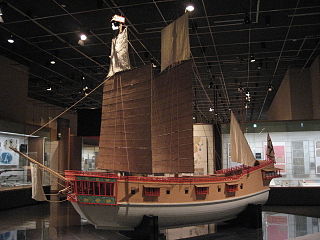
Red seal ships were Japanese armed merchant sailing ships bound for Southeast Asian ports with red-sealed letters patent issued by the early Tokugawa shogunate in the first half of the 17th century. Between 1600 and 1635, more than 350 Japanese ships went overseas under this permit system.

Hengqin is an island that lies mostly in Zhuhai, a prefecture-level city and special economic zone in Guangdong Province of the People's Republic of China. It has a population of about 3,000. Parts of Hengqin are leased to Macau by the State Council of the People's Republic of China, starting from 2009, mostly to house the new campus of the University of Macau. In the leased parts of the island, Macau law applies.
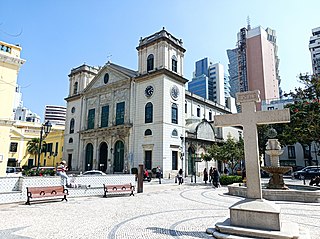
The Diocese of Macau is a Latin Church exempt ecclesiastical territory or diocese of the Catholic Church, in contrast with the Diocese of Hong Kong, which is, de jure, part of the Ecclesiastical Province of Guangdong.

Macau was under Portuguese rule from 1557 until 1999. During the final period of colonial administration prior to the handover of Macau to China, Portugal retained only limited numbers of military personnel in Macau for liaison and support purposes; the last major units having been withdrawn following the Carnation Revolution of 1974.

The Battle of Ameixial, was fought on 8 June 1663, near the village of Santa Vitória do Ameixial, some 10 kilometres (6.2 mi) north-west of Estremoz, between Spanish and Portuguese as part of the Portuguese Restoration War. In Spain, the battle is better known as the Battle of Estremoz.
Indians in Portugal, including recent immigrants and people who trace their ancestry back to India, together number around 104,000 − 120,000. They thus constitute 0.98% – 1.13% of the total population of Portugal.
Chinese people in Portugal form the country's largest Asian community, and the twelfth-largest foreign community overall. Despite forming only a small part of the overseas Chinese population in Europe, the Chinese community in Portugal is one of the continent's oldest due to the country's colonial and trade history with Macau dating back to the 16th century. There are about 30,000 people of Chinese descent residing in Portugal.
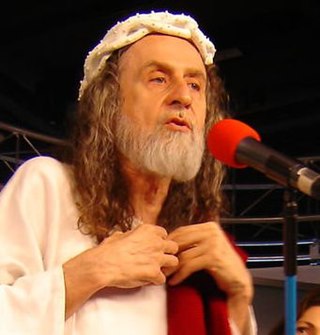
Álvaro Thais is a Brazilian astrologer, better known as Inri Cristo who claims to be the reincarnation of Jesus. He later moved to Curitiba, where he became famous as a persona in comedy television programs, getting to participate in a widely circulated advertising campaign.
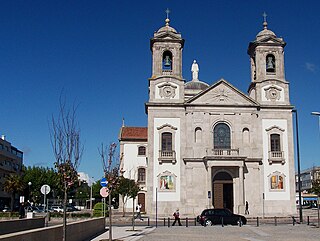
The Basilica of the Sacred Heart of Jesus is a Roman Catholic church, a Jesuit basilica, in Póvoa de Varzim, Portugal. It is part of the parish of Matriz and it is the largest temple in Póvoa de Varzim.
Luísa Dacosta was a Portuguese writer. In 2010 she was awarded the Vergílio Ferreira Prize by the University of Evora.

Slavery in Portugal existed since before the country's formation. During the pre-independence period, inhabitants of the current Portuguese territory were often enslaved and enslaved others. After independence, during the existence of the Kingdom of Portugal, the country played a leading role in the Atlantic slave trade, which involved the mass trade and transportation of slaves from Africa and other parts of the world to the Americas. The import of black slaves was banned in European Portugal in 1761 by the Marquis of Pombal, and at the same time, the trade of black slaves to Brazil was encouraged, with the support and direct involvement of the Marquis. Slavery in Portugal was only abolished in 1869.
Pedro de Araújo, was a Portuguese organist and composer who worked with the Roman Catholic Archdiocese of Braga, northern Portugal. He was singing master at the Conciliar Seminary of St. Peter and St. Paul in Braga between 1663 and 1668, and second organist at Braga Cathedral until 1665. Like Juan Cabanilles, he was one of the last representatives of the traditional concentrated Iberian style.
Jurubaça was a term for interpreter in the Portuguese colonies of Southeast Asia and the Far East, particularly in Macau. The term is prevalent in mid-sixteenth- through eighteenth-century documents. According to the Grande Dicionário da Língua Portuguesa, a Jurubaça was an “Antigo intérprete da Malásia e do Extremo Oriente,” an ancient interpreter in Malaysia and the Far East. The word derives from Malay jurubassa, which translates as a person who is an interpreter. The earliest document utilizing the word iurubaças dates from the sixteenth century.

Beatriz Amélia Alves de Sousa Oliveira Basto da Silva was born in Anadia, Portugal in 1944 and majored in history at the University of Coimbra with the thesis of Historiografia - o Conceito de História em António Caetano do Amaral.

Maria Ana de Sousa Leal da Costa, is a Portuguese sculptor.
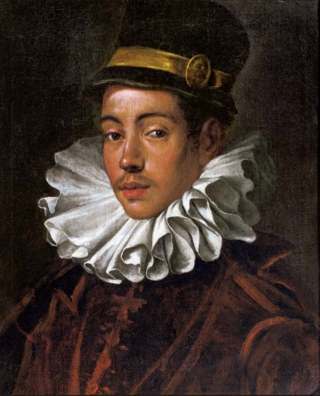
Itō Mancio was a Japanese Jesuit, head of the Tenshō embassy; the first Japanese diplomatic mission to Europe, and a Catholic priest.
Melchior Nunes Barreto (Belchior) was a 16th century Portuguese Jesuit priest who acted as a missionary in India, China, and Japan. He was born c. 1520 in Porto (Oporto), Portugal, and died in Goa, Portuguese India on 6 October 1571. Some sources claim that he died on 10 August 1571.

Gaspar Vilela or Gaspar Villela, was a priest and Jesuit missionary, and his activity in Japan influenced the Portuguese and Christian presence.














